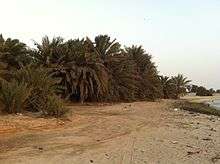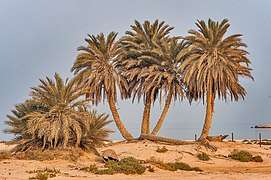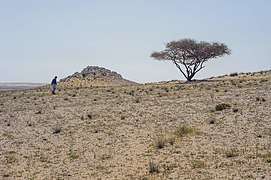Umm Bab
Umm Bab (Arabic: أم باب) is a settlement in Qatar, located in the municipality of Al-Shahaniya.[2] It used to be part of the Al Rayyan municipality and before that was administered by Al Jemailiya municipality before the latter was incorporated into Al Rayyan.[3] Umm Bab is well known locally for Al Khraij Beach, which is also known as 'Palm Tree Beach' owing to a small cluster of palm trees situated off the shoreline.[4]
Umm Bab أم باب | |
|---|---|
Settlement | |
 Umm Bab | |
| Coordinates: 25°12′35″N 50°48′48″E | |
| Country | Qatar |
| Municipality | Al-Shahaniya |
| Zone | Zone 84 |
| District no. | 559 |
| Area | |
| • Total | 131.1 km2 (50.6 sq mi) |
Aside from accommodating Qatar's first major non-oil related industry in the form of a cement processing facility which began operation in 1969,[5] there also exists minor oil and gas separation facilities within the settlement.[6]
Etymology
The settlement derived its name from local geographical features. Umm Bab translates to 'mother of gateway'. The 'gateway' portion of the name refers to a narrow path or opening in the area surrounded by two small hills which resemble a gateway.[7]
History
In 1948, shortly after the commencement of oil drilling operations in Dukhan, a housing village was built to the immediate south of Umm Bab to accommodate both Qatar Petroleum workers and locals of Umm Bab.[8] A road was built the same year to connect Umm Bab and Dukhan.[9] In 1961, the government inaugurated a boys school in the village. The housing village had approximately 50 households and a population of about 1,000 by 1990, most of which belonged to members of the Al Murrah tribe who were employed by Qatar Petroleum.[8]
Geography

Situated in western Qatar, Umm Bab is only 25 km away from the industrial city of Dukhan. It is 85 km west of the capital of Doha, 142 km southwest of Al Khor, and 100 km northwest of Al Wakrah.[10] The Aswan Quarries are to its southeast.[11]
Umm Bab is situated on the Dukhan anticline, a group of folds which runs in a NNW to SSE direction parallel with the western coast.[12]
Inhabitants of the village of Umm Bab have aired their grievances to the government of negative health effects from living in such close proximity (within 8 kilometres (5.0 mi)) of the cement plant as a result of air pollution. Furthermore, much of the natural flora has been harmed by quarrying operations.[13] At the clay quarry, about 20 kilometres (12 mi) south of the village, incomplete excavation has resulted in a series of small hillocks topped with lone trees surrounded by excavated earth.[14]
Infrastructure

The Umm Bab Coastal Center was opened in May 2017 by The Ministry of Interior's General Directorate of Coasts and Borders Security. Included within this center is a seaport, administrative buildings, and a boat maintenance shop. It is intended to serve as the primary coastguard station for the directorate's Western District.[15]
Industry
Umm Bab is one of only two sites in Qatar from which large quantities of limestone and clay can be easily excavated, the other site being Umm Salal.[16] Furthermore, north of Umm Bab is massive quantities of silica sand, which is used in the blending of cement and in construction.[17] In 1965, the government capitalized on Umm Bab's rich natural resources by headquartering the Qatar National Cement Company in the area,[18] approximately 8 kilometres (5.0 mi) north from the village of Umm Bab.[19] This decision also served as an impetus to develop Qatar's western region.[16]
The first processing of cement took place in 1969, and the factory received its water supply from Rawdat Rashed and its oil supply from Dukhan.[20]
An 85 km-long pipeline was built here in the 1940s and in December 1949 it facilitated the first oil export from Dukhan to Mesaieed.[21]
Transport
Concurrent with Qatar Petroleum's establishment of the housing village in Umm Bab in the late 1940s, the first paved road was built linking the village with Dukhan. In turn, the village was also connected to Doha through this same road.[22]
Archaeology
The archaeological site of Asaila is near Umm Bab.[23] It was discovered by a French archaeological team that surveyed and excavated several sites in Qatar between 1976 and 1982.[24] By 1981, the team had excavated Asaila.[23] This site was revisited by a joint German–Qatari archaeological team which was formed in 2012. The artifacts recovered at the site indicate a human presence during the early Neolithic period, c. 8,000 years ago.[24] Several other archaeological sites have been discovered near Umm Bab.[25]
In July 2018, a resident alerted archaeologists to the first inland rock art site in the country near Umm Bab. Rock samples were collected and are pending analysis on their dating.[26]
Gallery
 Desert Thumbs (Cynomorium coccineum, local name tartouth) on a beach near Umm Bab.
Desert Thumbs (Cynomorium coccineum, local name tartouth) on a beach near Umm Bab. Cluster of palm trees near Umm Bab beach.
Cluster of palm trees near Umm Bab beach. Rocky lightly vegetated desert south of Umm Bab with a single Acacia tortilis tree.
Rocky lightly vegetated desert south of Umm Bab with a single Acacia tortilis tree.
References
- "District Area Map". Ministry of Development Planning and Statistics. Retrieved 11 February 2019.
- "2015 Population census" (PDF). Ministry of Development Planning and Statistics. April 2015. Retrieved 8 August 2017.
- "2004 population census". Qatar Statistics Authority. Retrieved 1 July 2015.
- "Beaches". Qatar Tourism Authority. Archived from the original on 6 July 2015. Retrieved 1 July 2015.
- Looney, Robert E. (March 1990). "Structural Impediments to Industrialization in Qatar". Calhoun: The NPS Institutional Archive. p. 19. Retrieved 24 June 2018.
- "National Implementation Plan (NIP) for Stockholm Convention on Persistent Organic Pollutants (POPs)". Ministry of Municipality and Environment. p. 6. Retrieved 24 June 2018.
- Jacques LeBlanc (March 2008). "A fossil hunting guide to the tertiary formations of Qatar, Middle East".
- Fahd Abdul Rahmn Hamad Al-Thani (1992). "The Spatial Impact of the Hydrocarbon Industry on Land and Sea Use in Qatar" (PDF). University of Durham; Durham e-Thesis. p. 148.
- Fahd Abdul Rahmn Hamad Al-Thani (1992). "The Spatial Impact of the Hydrocarbon Industry on Land and Sea Use in Qatar" (PDF). University of Durham; Durham e-Thesis. p. 138.
- Whelan, John (1983). Qatar, a MEED practical guide. London: Middle East Economic Digest. p. 160. ISBN 0950521191.
- Fahd Abdul Rahmn Hamad Al-Thani (1992). "The Spatial Impact of the Hydrocarbon Industry on Land and Sea Use in Qatar" (PDF). University of Durham; Durham e-Thesis. p. 156.
- LeBlanc, Jacques (February 2017). "Origin and types of silica in the Lower Eocene Carbonates of the Rus Formation, Qatar, Middle-East" (PDF). p. 84. Retrieved 24 February 2019.
- Fahd Abdul Rahmn Hamad Al-Thani (1992). "The Spatial Impact of the Hydrocarbon Industry on Land and Sea Use in Qatar" (PDF). University of Durham; Durham e-Thesis. p. 156.
- Max Cortesi. "Umm Bab Clay Quarry". atlasobscura.com. Retrieved 24 February 2019.
- "MoI opens Umm Bab Coastal Center". Qatar Tribune. 23 May 2017. Retrieved 6 July 2018.
- Al-Kubaisi, Mohammed Ali M. (1984). Industrial development in Qatar: a geographical assessment (PDF). Durham E-Theses, Durham University. p. 151.
- Economical and Social Infrastructures in the State of Qatar. Doha: Al Noor Pub. 1984. p. 20.
- "About the company" (in Arabic). Qatar National Cement Company. Retrieved 29 July 2015.
- Fahd Abdul Rahmn Hamad Al-Thani (1992). "The Spatial Impact of the Hydrocarbon Industry on Land and Sea Use in Qatar" (PDF). University of Durham; Durham e-Thesis. p. 156.
- Al-Kubaisi, Mohammed Ali M. (1984). Industrial development in Qatar: a geographical assessment (PDF). Durham E-Theses, Durham University. p. 152.
- Fahd Abdul Rahmn Hamad Al-Thani (1992). "The Spatial Impact of the Hydrocarbon Industry on Land and Sea Use in Qatar" (PDF). University of Durham; Durham e-Thesis. p. 60.
- Fahd Abdul Rahmn Hamad Al-Thani (1992). "The Spatial Impact of the Hydrocarbon Industry on Land and Sea Use in Qatar" (PDF). University of Durham; Durham e-Thesis. p. 325.
- Qatar: Year Book 1980–81. Doha: Press and Publications Department, Ministry of Information. 1981. p. 74.
- "World Heritage" (PDF). Vol. 72. UNESCO. June 2014. p. 83. Retrieved 5 July 2018. Cite magazine requires
|magazine=(help) - "World Heritage" (PDF). Vol. 72. UNESCO. June 2014. p. 80. Retrieved 5 July 2018. Cite magazine requires
|magazine=(help) - "Qatar Museums to resume excavation after summer to explore Qatar's history". The Peninsula. 23 July 2018. Retrieved 23 July 2018.